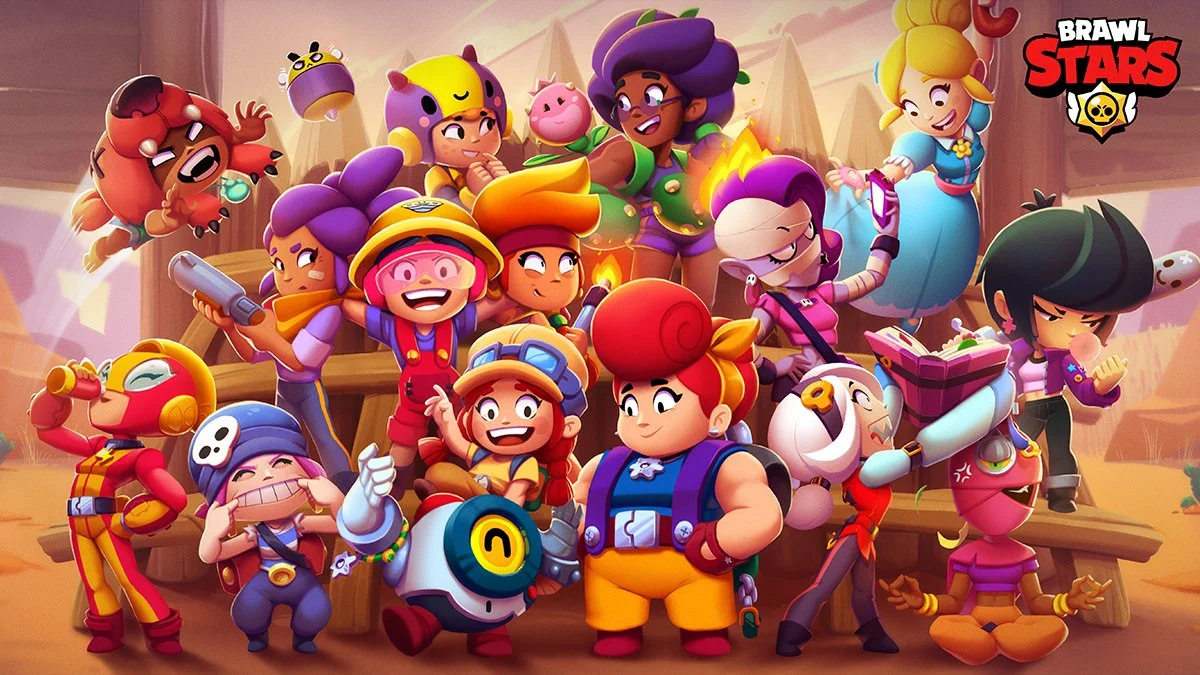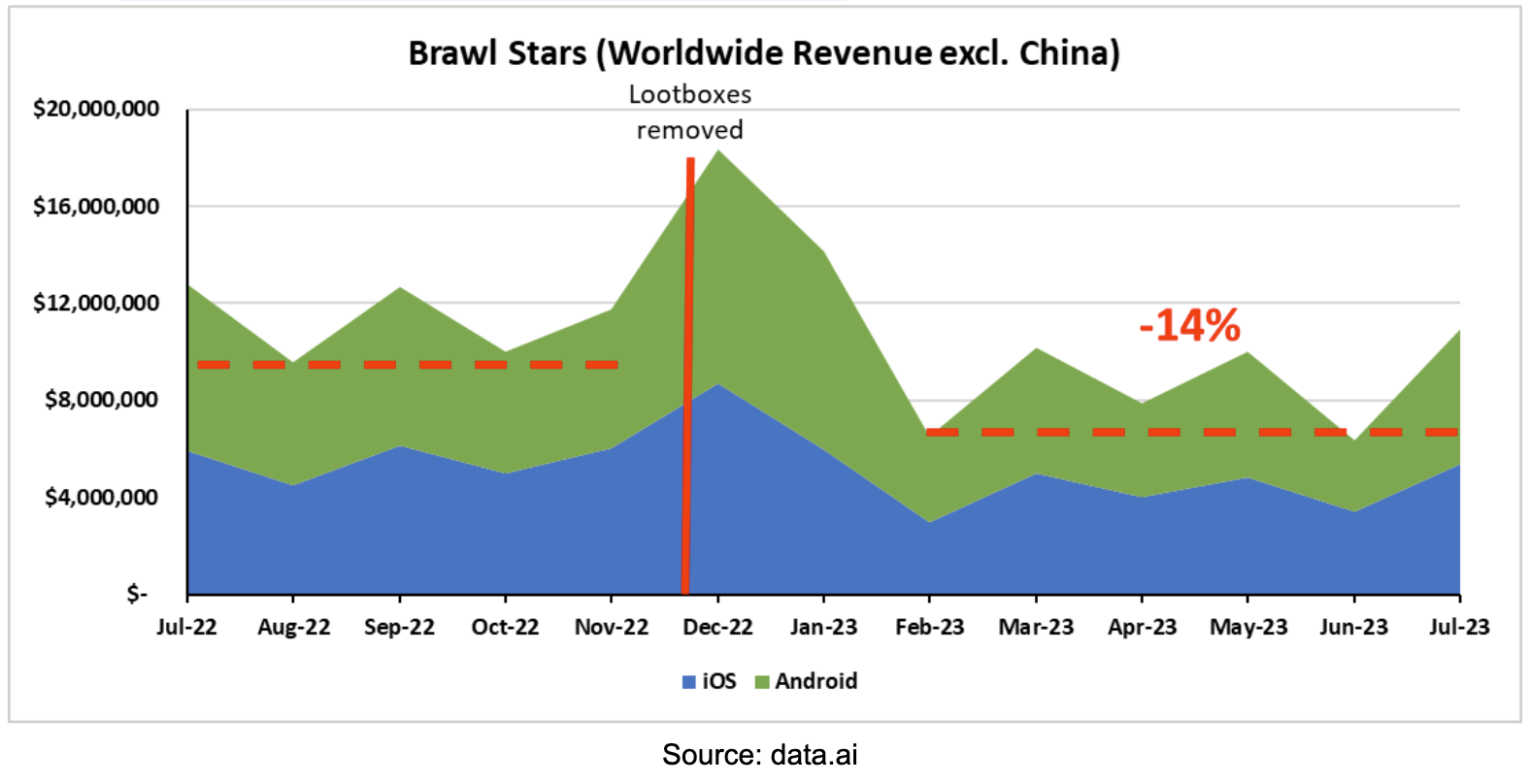Why Removing Loot Boxes in Brawl Stars Failed
On December 12th, 2022, Brawl Stars removed its loot boxes, replacing it with a ‘direct purchase’ system for acquiring content. This move shocked many within the industry and generated polarized opinions among experts.
At the time, we wrote an early analysis about the entire deal covering the specific changes. However, back then we couldn’t assess the actual impact because during that period there was a huge flow of downloads and the effect of Xmas, which boosted the daily revenue.
Months later, we can finally determine if the removal of Brawl Stars’ boxes was a mistake, and why.
Let’s begin with the facts:
The 5 month period after removing boxes generated -14% less revenue for Brawl Stars. (This calculation excludes December 2022, which boosted revenue due to the winter holidays). In my opinion this is mainly because of the box removal but other possibilities are discussed later in this article.
Both Android and iOS were impacted, but in the latter the impact was even more pronounced (-18% on iOS vs -11% on Android). In terms of countries, the loss was widespread (although some specific territories experienced growth). But it seems that countries with high RPD (Revenue per Download) were more affected.
Where is that negative impact coming from?
The fact that the loss is more noticeable on iOS (a platform that typically has more high spenders than Android) and in high RPD countries leads me to suspect that the negative impact has mainly stemmed from reduced spending among high spenders.
This theory aligns with one of the risks we highlighted earlier: That the new system brought a significant loss of vertical spend depth.
In the previous model (with boxes), certain valuable upgrades (Star Powers, Gadgets, and Gears) had to be obtained from boxes. Furthermore, acquiring ‘high rarity brawlers not included in the Pass’ also required opening boxes. This translated into a substantial spending for hardcore players that wanted to obtain and maximize new content very fast.
However, in the new system (without boxes), all upgrades are bought directly with grindable in-game soft currency. And new Brawlers not part of the Pass can be purchased outright or through in-game currency. This approach decreases the costs by allowing hardcore players to acquire those contents at a fixed price and use resources that they might have previously earned through gameplay.
In my view, this is the most logical explanation on why the game revenue has decreased despite an increment on the amount of Brawlers released outside of the Pass, and no negative variations in terms of Downloads and, by extension, in Daily Active Users.
An alternative explanation to the decline, raised in the DoF Slack community, is that Brawl Stars already had been experiencing a dramatic decline in revenue since May 2021 - months prior to the loot box removal. As a result, some experts in our community have suggested that not all of the revenue gap is due to the boxes removal, but a continuation of this pre-existing negative trend.
While possible, I am not entirely convinced by this explanation: I believe that the decaying revenue trend had stabilized by August 2022, leading me to conclude that the gap between November 2022 and January 2023 has been primarily caused by the removal of the boxes.
While I don’t have a definitive answer on what exactly stopped the previous decline, I think it was primarily related to a decrease in Downloads. A strong correlation between both KPIs can be seen in the graph below:
Nevertheless, I think that the negative revenue trend provides insights into the reasons that prompted the Brawl Stars devs to make such significant changes to the game’s progression and monetization model: One key reason behind these changes was to try to revitalize Brawl Stars.
Finally, some other DoF community members stated that the removal of loot boxes had negative implications for the engagement as well, as it removed the thrill of obtaining something great when opening them.
While I don’t think this is a big factor in the decline of revenue, I think their point must have something of truth, at least judging by the fact that in June 2023 Brawl Stars introduced a sort of reward boxes called Starr Drops, which grant random rewards (including Brawlers), as a reward for winning matches.
This brings back to some degree the sense of fun when being lucky.
However, this doesn’t mean that Brawl Stars have brought loot boxes back:
Players can’t buy Starr Drops in any way (at least at the moment). They are exclusively obtained when achieving a certain amount of victories per day. So it’s a randomized reward system oriented to improve engagement.
And ultimately, the direct purchase mechanisms for everything that before was obtained in boxes (Brawlers Gadgets, Star Powers…) are still there.
So was removing loot boxes a mistake?
Based on the available data, from a business perspective the removal of boxes has been entirely negative for Brawl Stars. Not only revenue has decreased, but none of the available key performance indicators (KPIs) show any kind of improvement.
It’s possible (although I remain skeptical) that contrary to what data.ai estimates, the change may have led to some improvement in player engagement and by extension Active Users. However, even if this were the case, it hasn’t been enough to counterbalance the blow to monetization. My intuition is that the change has not increased the stickiness for existing or returning players too much.
In summary, if the goal was to guide Brawl Stars back to the level of performance seen in 2020-2021, it appears they are now further away from that goal than before.But while the action overall was a failure, at least it wasn’t a critical fumble:
In the earlier piece we discussed the different actions that Brawl Stars had undertaken to prepare for the removal of boxes. They seemed so on point I incorrectly predicted a positive long-term outcome.
While my prediction turned out to not be true, the fact that the revenue decline has been only 14% is noteworthy. After all, in Brawl Stars loot boxes at one point likely represented the biggest chunk of its monetization. It’s an indicator that the adaptations worked out at least partially.
Finally, I still think that the idea of removing loot boxes wasn’t inherently wrong, but rather the execution. From my perspective, several of the intuitions I believe that led to the decision of removing loot boxes are correct:
The monetization of a game where the average player is ~13 years old can’t be based on spending hundreds of dollars on loot boxes. That business model is not sustainable over time, let alone unable to survive the analysis of parents and regulators. This is particularly relevant to Brawl Stars compared to other Supercell games, given its focus on younger audiences.
Reinvigorating Brawl Stars to reach its past performance requires increasing the capacity of the game to attract and re-engage lapsed players, and this requires a revision of both content acquisition mechanisms and the content management in general.
So while this specific attempt has fallen short, I don’t believe that the mistake was to remove loot boxes. Rather, the misstep was introducing these changes abruptly instead of gradually. This approach carried unnecessary risks, and ultimately led to an inadequate solution that now requires painstaking rectification.
For example, having a new progression system running in parallel with boxes for a period of time would’ve allowed devs to detect and tackle unexpected issues with the way how hardcore players monetize.
How could Brawl Stars turn it around?
In my opinion (which is entirely speculative because I don’t have access to their internal data and research), there are several actions that Brawl Stars could explore to recover its performance.
If the revenue issue with the loot box removal is primarily connected to the decreased spending in new content by high spenders, introducing time limited events around the acquisition and upgrade of a new rarity of brawlers could be a great way to increase spending depth.
These Time Limited Events could temporarily require an exclusive currency or challenges to acquire and upgrade new brawlers, thus decreasing the effect of past grinding and opening the door for additional products like an Event Pass or exclusive cosmetics.
Furthermore, it would allow to gate in a different way the Gadgets and Star Powers, which now are purchased with soft currency and are one of the weakest points of the upgrade system. All while maintaining the general rules for the regular content.
An alternative solution would be to introduce a new rarity of brawlers that required unique and harder to grind resources, although this might be perceived more negatively by players.
Additionally, to reactivate and maintain a broader player population to set the game trend towards its previous excellent performance, Brawl Stars perhaps should double down into a more ambitious liveops strategy.
For instance, instead of 2-month “predictable” seasons, the content of which many players complete before the deadline, perhaps Brawl Stars should have a more active approach, filled with gameplay surprises, content drops and challenges mid-season, akin to Fortnite.
A more regular flow of new content and game experiences - let alone the usage of external IPs - could increase the volume and retention of reactivated users, and introduce more opportunities to promote exclusive cosmetics.
Final conclusions
My opinion was, and still is, that the removal of loot boxes in Brawl Stars, even if successful, would not represent a major shift in mobile games regarding the usage of gacha mechanics. This is because many of the characteristics of Brawl Stars - such as the big weight of cosmetics in monetization and the relatively lower impact of high spenders due to the young core audience - are not shared by most games in the market.
Given that the attempt has failed, this is even more unlikely. Even in the context of Brawl Stars, where high spenders likely contribute proportionally less to total revenue compared to other genres, their influence is substantial enough to significantly impact revenue if not properly accounted for.
As for Brawl Stars, I believe that the story is far from over. The fact that the development team had the courage to take drastic actions like these shows their determination to resist the game's decline. This deserves praise because not all game teams - particularly those operating such large games - would be willing to take such risks.
Perhaps one insight I've gained from this experience is that, rather than relying solely on a single monumental change as a pivotal moment, the path to success is better forged gradually and methodically, by understanding of each component within the intricate machinery of a game.
Written by Javier Barnés. Special thanks to my friend V. Freso and the kids from his class for their thoughts on how the removal of loot boxes has affected the way they play. And thanks to the great Phillip Black for kicking off this topic on DoF.









